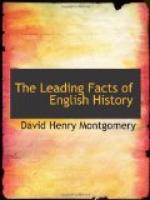In Merton’s and Wykeham’s institutions young men of small means were instructed, and in great measure supported, without charge. They were brought together under one roof, require to conform to proper discipline, and taught by the best teachers of the day. In this way a general feeling of emulation was roused, and at the same time a fraternal spirit cultivated, which had a strong influence in favor of a broader and deeper intellectual culture than the monastic schools at Oxford and elsewhere had encouraged.
272. Literature.
The most prominent historical work was that by Matthew Paris, a monk of St. Alban’s, written in Latin, based largely on earlier chronicles, and covering the period from the Norman Conquest, 1066, to his death, in 1259. It is a work of much value, and was continued by writers of the same abbey.
The first English prose work was a volume of travels by Sir John Mandeville, dedicated to Edward III. It was followed by Wycliffe’s translation of the Bible into English from the Latin version, and by Chaucer’s “Canterbury Tales,” the first great English poem.
273. Architecture.
Edward I and his successors began to build structures combining the palace with the stronghold.[1] Conway and Carnavon Castles in Wales, Warwich Castle, Warwickshire, and a great part of Windsor Castle on the Thames, twenty-three miles west of London, are magnificent examples; the last is still occupied as a royal residence.
[1] The characteristic features of the Edwardian castles are double surrounding walls, with numerous protecting towers, and the omission of the square Norman keep.
In churches, the massive architecture of the Normans, with its heavy columns and round arches, was followed by the Early English style or the first period of the Gothic, with pointed arches, slender, clustered columns, and tapering spires. Salisbury Cathedral is the grandest example of the Early English style.
Later, the Decorated Style was adopted. It was characterized by broader windows, highly ornamented to correspond with the elaborate decoration within, which gave this style its name; this is seen to advantage in Exeter Cathedral, York Minster, and Merton College Chapel at Oxford.
V. General Industry and Commerce
274. Fairs; Guilds.
The domestic trade of the country was largely carried on during this period by great fairs held at stated times by royal license. Bunyan, in “Pilgrim’s Progress,” gives a vivid picture of one of these centers of trade and dissipation, under the name of “Vanity Fair.” Though it represents the great fair of Sturbridge, near Cambridge, as he saw it in the seventeenth century, yet it undoubtably describes similar gatherings in the time of the Plantagenets.




